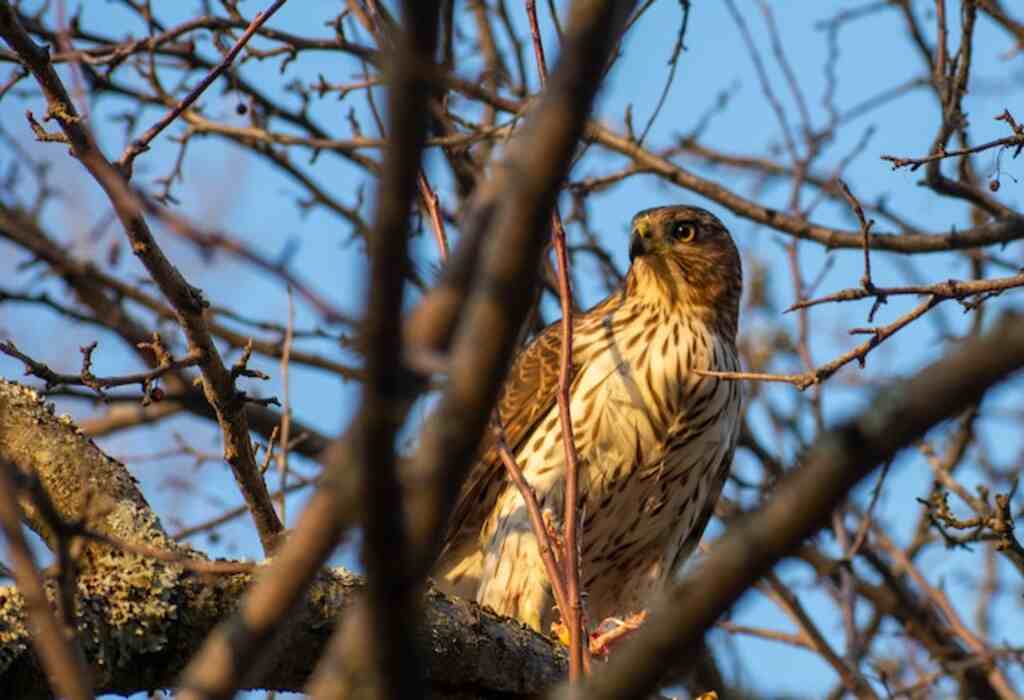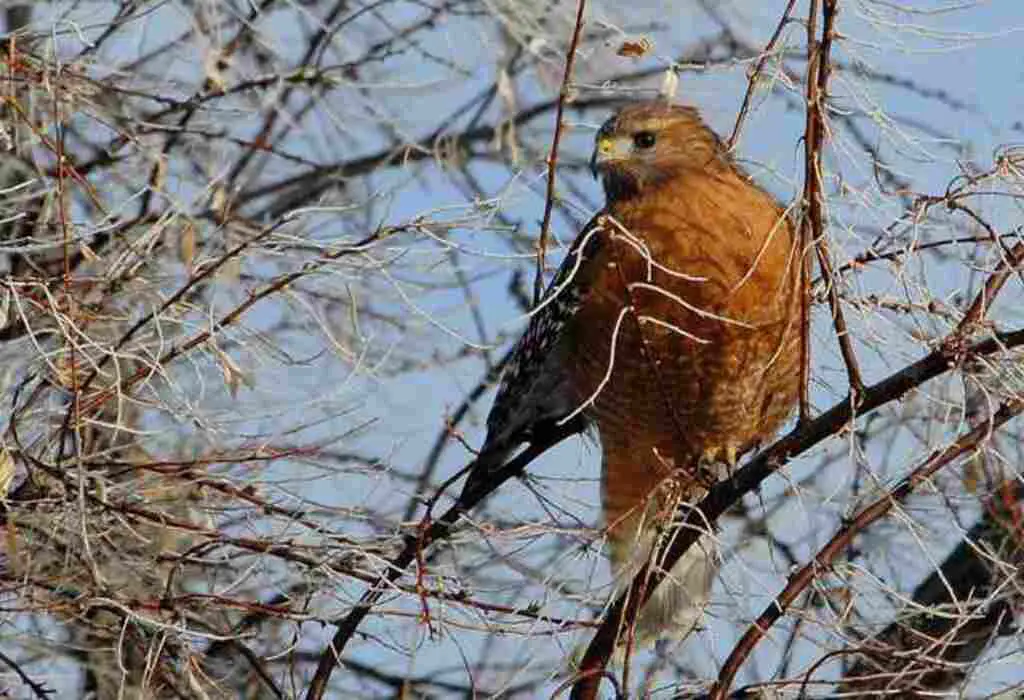Do Hawks Eat Blue Jays? Ah, the age-old question that has intrigued bird enthusiasts for ages. Picture this: the elegant hawks soaring through the sky, and the feisty blue jays flaunting their vibrant blue feathers.
But what happens when these two avian worlds collide? Join us on a captivating journey as we delve into the depths of this predator-prey relationship.
From the hunting habits of hawks to the fierce nature of blue jays, we’ll uncover the secrets behind their interactions.
Brace yourself for a wild ride through the world of bird drama, as we explore the significance of blue jays in the ecosystem and the potential impact of their feathery fate at the talons of hawks.
Get ready to spread your wings and join us on this thrilling adventure!
Table of Contents
- 1 Key Takeaways
- 2 Do Hawks Eat Blue Jays?
- 3 Overview of Hawks and Blue Jays
- 4 The Diet of Hawks
- 5 The Physical Characteristics of Blue Jays
- 6 The Aggressive Nature of Blue Jays
- 7 Research Studies on the Relationship Between Hawks and Blue Jays
- 8 Cases of Hawks Preying on Blue Jays
- 9 Factors that Affect the Probability of Hawks Preying on Blue Jays
- 10 Other Predators of Blue Jays
- 11 The Significance of Blue Jays in the Ecosystem
- 12 Frequently Asked Questions
- 13 Conclusion
- 14 Author
Key Takeaways
- Hawks are known to prey on blue jays as part of their diet, confirmed by pellet analysis.
- Blue jays have developed defense mechanisms such as mobbing behavior and mimicry, but are still vulnerable to predation due to their bright feathers and loud vocalizations.
- Blue jays play a crucial role in distributing seeds and serving as a food source for larger predators, making their loss significant for the ecosystem.
- Understanding the factors affecting the probability of hawks preying on blue jays can inform conservation efforts and shed light on bird predation dynamics.
Do Hawks Eat Blue Jays?
Yes, hawks are known to eat blue jays. Hawks are opportunistic predators that feed on a variety of small to medium-sized birds, including blue jays.
They have keen eyesight and agile flight, enabling them to catch birds in mid-air or ambush them on the ground.
Blue jays, being relatively common and visible birds, can become targets for hawks during hunting.
However, it’s important to note that hawks have diverse diets and will also consume other prey such as rodents, insects, and reptiles.
Overview of Hawks and Blue Jays
An examination of the feeding habits of hawks and blue jays reveals distinct differences in their diets and hunting methods.
Hawks are birds of prey that are known for their sharp talons and keen eyesight, which they use to hunt small mammals, birds, and reptiles.
They prefer to hunt in open areas such as fields and meadows, though some species are adapted to hunting in forested areas as well.
In contrast, blue jays are omnivores that feed on a variety of foods, including insects, nuts, seeds, and fruits.
They are known for their raucous calls and are often found in wooded areas, where they build their nests in trees. Blue jays are monogamous birds and typically mate for life.
They build their nests in trees and lay eggs in the spring, which they incubate for about 16-18 days before hatching.
Understanding these habitat preferences and breeding habits is important in order to better understand the diets of these birds.
Moving into the subsequent section about the diet of hawks, it’s important to note that their hunting methods and habitat preferences play a crucial role in the types of prey they consume.
The Diet of Hawks
The dietary habits of raptors often involve the consumption of smaller bird species such as the blue jay. Hawks, being a type of raptor, have a varied diet that includes rodents, reptiles, and insects, but they also prey on other birds.
They are known to have a preference for birds that are similar in size to blue jays and hunt them during their migration in the fall.
Hawks are ambush predators and have specific hunting patterns that involve scanning open areas and soaring high above trees, waiting for prey to appear.
They are known to swoop down suddenly and surprise their prey, using their sharp talons to capture and kill their target.
Understanding the hunting patterns and dietary preferences of hawks sheds light on why blue jays are a common prey for these birds of prey.
The physical characteristics of blue jays also play a role in their vulnerability to being hunted by hawks, which we will explore in the subsequent section.
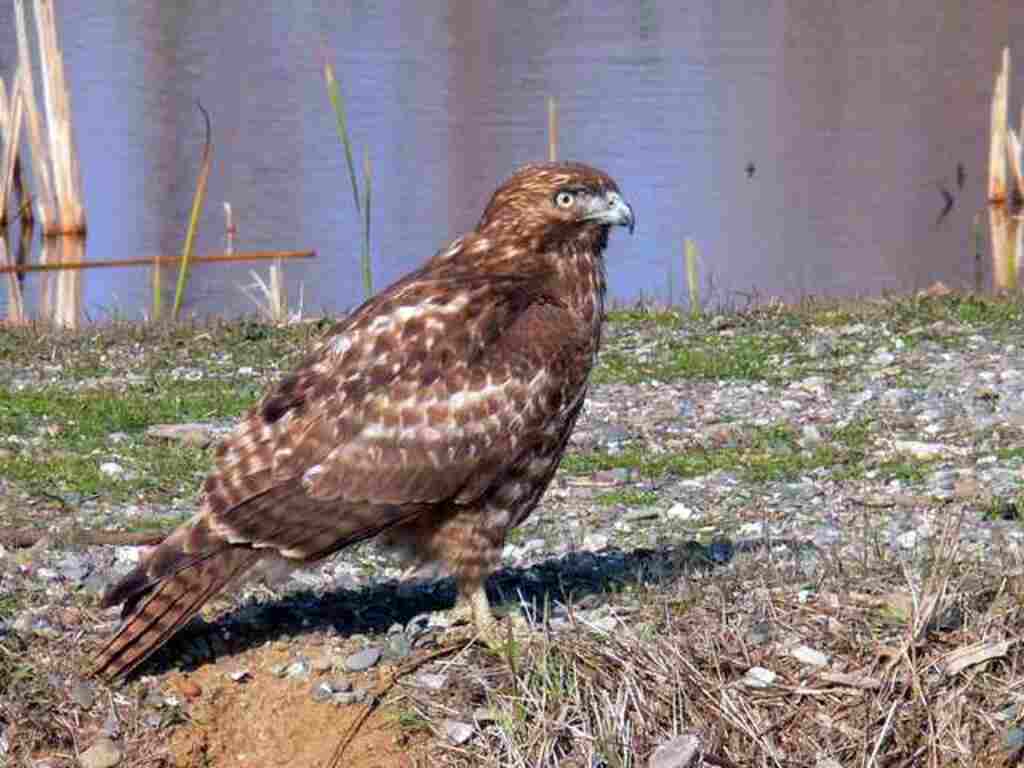
The Physical Characteristics of Blue Jays
Blue jays possess physical attributes that make them vulnerable to predation by hawks. These birds have bright blue feathers that make them highly visible in their natural habitat.
Blue jays are also known for their loud vocalizations and communication, which can attract predators like hawks.
In addition to their physical characteristics, blue jay behavior and mating habits can also make them easy targets for hawks.
During mating season, blue jays become territorial and aggressive, which can attract the attention of predators.
While blue jays are known for their feisty nature, they are no match for the speed and agility of hawks.
With their sharp talons and powerful wings, hawks are able to swoop down and capture blue jays with ease. This aggressive nature of blue jays makes them even more vulnerable to predation by hawks.
The Aggressive Nature of Blue Jays
With their sharp beaks and powerful wings, blue jays are known for their aggressive behavior towards other birds and animals in their environment.
They are territorial creatures that fiercely defend their nests and food sources from potential threats, regardless of their size or strength.
Blue jays are notorious for their loud and aggressive calls, which they use to intimidate intruders and warn others of potential danger.
They are also known to attack and chase away other birds, including larger species such as hawks, in order to protect their territory.
This aggressive behavior has been studied extensively by researchers who seek to understand the relationship between blue jays and other birds, including hawks.
Through their research studies, they have uncovered interesting insights into the complex dynamics of these birds and the role that aggression plays in their survival.
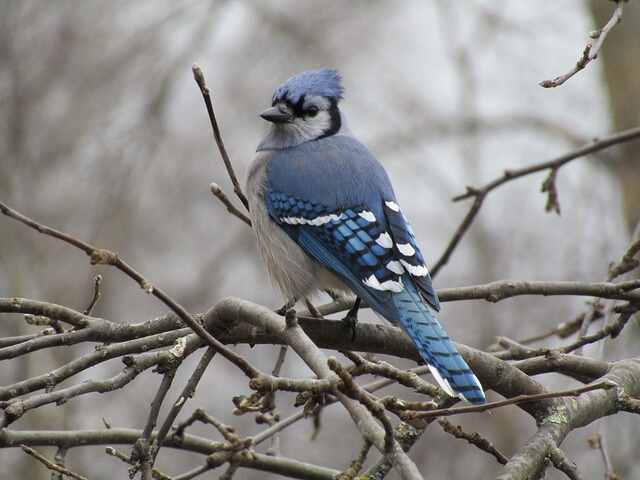
Research Studies on the Relationship Between Hawks and Blue Jays
Research studies have been conducted on the relationship between hawks and blue jays, with a focus on observing their interactions in the wild, analyzing hawk pellets to determine if blue jays are a common prey item, and conducting experiments to investigate the behavior of both species.
Observations in the wild have shown that hawks are known to prey on blue jays, which may explain the aggressive behavior of blue jays towards hawks.
Analysis of hawk pellets has confirmed that blue jays are indeed a common prey item for certain species of hawks.
Observations in the Wild
In natural settings, it has been observed that hawks consume members of the Corvidae family, which includes blue jays, as a part of their diet.
Studies on hawk behavior and prey selection have shown that they are skilled hunters who use various strategies to catch their prey.
Blue jays, on the other hand, have developed defense mechanisms to avoid being hunted, such as mobbing behavior and mimicry.
Despite their efforts, hawks are still able to hunt and consume blue jays in the wild. To better understand the relationship between hawks and blue jays, scientists have analyzed hawk pellets.
These pellets contain the undigested remains of their prey and can give insight into their diet and feeding habits.
Analysis of Hawk Pellets
The undigested remains found in hawk pellets provide valuable insights into the dietary habits and feeding behaviors of these predatory birds.
Analysis techniques such as dissecting hawk pellets have been used to identify the common prey items of hawks.
These pellets contain the remnants of bones, feathers, and other indigestible parts of prey that have been consumed and regurgitated by the hawk.
Through the identification of these remains, researchers have been able to determine that hawks do in fact feed on blue jays, along with other small birds, rodents, and insects.
This information can help further our understanding of predator-prey relationships in the wild and provide insight into the potential impact of hawks on local ecosystems.
Moving forward, experimentation can be conducted to explore the extent of hawk predation on blue jays and its potential effects on their population dynamics.
Experimentation
As we learned from our previous subtopic, analyzing hawk pellets can provide valuable information about the dietary habits of these birds of prey.
However, to further understand the feeding preferences and behavioral interactions of hawks with blue jays, experimentation is necessary.
In this current subtopic, we will discuss possible experiments that could shed light on this topic.
One such experiment involves observing the interactions between hawks and blue jays in a controlled environment, such as a large aviary.
A table outlining the potential variables and observations for this experiment is shown below.
Other experiments could involve analyzing the chemical makeup of hawk stomach contents or tracking the movements of hawks and blue jays in the wild.
By conducting these experiments, we can gain a better understanding of the complex relationships between these two species.
This understanding may also lead to the development of conservation strategies that protect both hawks and blue jays in their natural habitats.
Moving forward, we will explore cases of hawks preying on blue jays to continue our investigation into this topic.
| Variable | Observation | Valuable Information |
|---|---|---|
| Species | Blue Jay, Hawk | Identifying the participants |
| Number of Individuals | Count of blue jays and hawks present | Understanding population dynamics |
| Time of Interaction | Duration and frequency of hawk-blue jay encounters | Determining activity patterns |
| Behavior | Aggressive interactions, hunting, feeding, etc. | Examining interspecies dynamics |
| Vocalizations | Types and frequency of calls between the species | Communication signals and their significance |
| Flight Patterns | Flight paths, aerial maneuvers during interactions | Studying predator-prey strategies |
| Prey Preference | Proportion of blue jays targeted by hawks | Assessing food preferences and selection |
| Success Rate | Percentage of attempted predation events | Evaluating hunting efficiency |
| Social Hierarchy | Dominance and territorial behavior between species | Understanding dominance relationships |
| Body Language | Postures, wing displays, tail flicking, etc. | Decoding visual signals and communication |
These variables and observations can help analyze the dynamics and outcomes of interactions between hawks and blue jays within the controlled environment of the aviary.
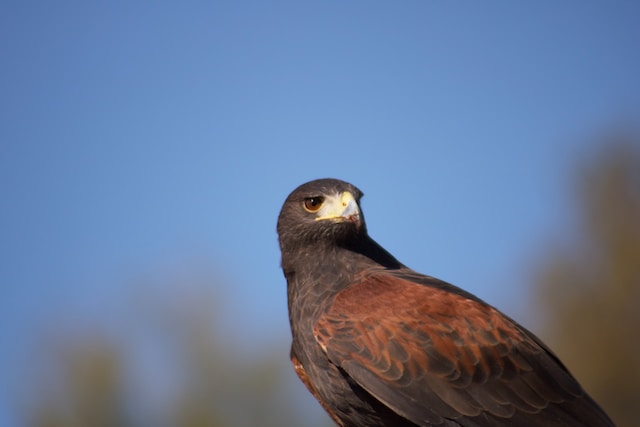
Cases of Hawks Preying on Blue Jays
The subtopic of cases of hawks preying on blue jays is an area of interest in the study of avian predator-prey relationships.
Evidence from observations has shown that hawks do indeed prey on blue jays, with particular species of hawks displaying a preference for this prey.
Additionally, examination of hawk pellets has revealed the remains of blue jays, providing further evidence of their presence in the diet of hawks.
These findings contribute to a greater understanding of the ecological dynamics between these two bird species.
Evidence from Observations
Observational evidence reveals that the feeding habits of hawks include blue jays as a potential prey item. Hawks are known to be opportunistic predators and will consume a variety of prey items, including small mammals, reptiles, and birds.
Blue jays, being small and agile, are often targeted by hawks. They are also known to engage in agonistic interactions with hawks, further suggesting that they are a potential food source.
Observations have shown hawks swooping down and attacking blue jays in mid-air, as well as targeting them while perched in trees.
This behavior has been observed in various hawk species, including Cooper’s hawks and sharp-shinned hawks.
The frequency of this behavior varies depending on the region and time of year, but it is clear that hawks do prey on blue jays.
This evidence sets the stage for further investigation into the feeding ecology of hawks.
The subsequent section will explore evidence from hawk pellets, which provides additional insight into the prey items consumed by hawks.
Evidence from Hawk Pellets
Observations are not the only way to determine the diet of hawks. Another method is through analyzing hawk pellets, which are undigested remains of prey that hawks regurgitate.
Hawk pellet analysis has been used extensively to investigate the prey composition of various raptor species.
By closely examining the contents of hawk pellets, scientists can identify the different species of prey that hawks consume.
This method has proven to be an effective way to study the eating habits of hawks, including their predation on blue jays.
Hawk pellet analysis has revealed that blue jays are indeed a common prey item for many hawk species.
By understanding the prey composition of hawks, researchers can gain insight into the factors that affect the probability of hawks preying on blue jays.

Factors that Affect the Probability of Hawks Preying on Blue Jays
The probability of hawks preying on blue jays is influenced by several factors.
One such factor is the size and weight of the blue jay, as larger birds may be less vulnerable to predation.
Additionally, the availability of other prey in the area can affect the likelihood of a hawk targeting a blue jay.
Finally, habitat can also play a role, as certain environments may provide more cover and protection for potential prey.
Understanding these factors can provide valuable insights into the dynamics of bird predation and help inform conservation efforts.
Size and Weight of the Blue Jay
Despite the Blue Jay’s relatively small size and lightweight, it is still a formidable prey for many predators, including hawks.
The Blue Jay’s size and weight discussion is an important factor in determining its vulnerability to predation.
Although the Blue Jay weighs only about 70-100 grams, it is still considered a large bird compared to other songbirds.
Hawks, being opportunistic hunters, will target any available prey, and the Blue Jay is no exception.
In fact, the Blue Jay’s distinctive blue coloration and loud vocalizations make it a highly visible and attractive target for hawks.
However, the Blue Jay’s agility and speed may enable it to evade predators in some instances.
| Bird Species | Average Length (cm) | Average Weight (g) |
|---|---|---|
| Blue Jay | 30 – 35 | 70 – 100 |
| Cardinal | 21 – 23 | 33 – 65 |
| Robin | 22 – 25 | 72 – 95 |
| Sparrow | 12 – 15 | 20 – 35 |
| Finch | 11 – 14 | 10 – 25 |
Please note that the values provided are approximate ranges for the average length and weight of each bird species. Actual measurements may vary within these ranges.
It’s important to remember that while size and weight provide insights into relative differences among bird species, susceptibility to predation is influenced by various factors, including flight patterns, behavior, and habitat.
Additionally, individual variation within species can affect size and weight, so these ranges should be seen as general guidelines rather than strict boundaries.
Availability of Other Prey
An important factor to consider when examining the predation of Blue Jays is the availability of other prey species, which can influence the likelihood of hawks targeting this bird.
Hawks are opportunistic predators and will typically target the most abundant prey in their environment. Thus, if there are a variety of prey species available, hawks may not specifically target Blue Jays.
Additionally, predator population dynamics can also play a role in the predation of Blue Jays. If the hawk population is low, the likelihood of a Blue Jay being targeted may decrease.
However, if the hawk population increases, Blue Jays may become more vulnerable to predation.
Therefore, understanding the prey availability and predator population dynamics in a given habitat is essential in understanding the predation of Blue Jays.
As we move into the next section about habitat, it is important to consider how the availability of prey and predators can vary across different environments.
Habitat
Habitat plays a crucial role in determining the abundance and diversity of prey and predators, which can ultimately affect the predation of Blue Jays.
Hawks are known to inhabit a wide range of habitats, from forests to grasslands, and their adaptability allows them to hunt a variety of prey species.
However, the availability of prey in these habitats can affect the hunting success of hawks. For example, in urban areas, blue jays may be more abundant due to the presence of bird feeders and gardens.
In this setting, hawks may face competition with other bird predators such as cats and squirrels.
On the other hand, in rural areas, blue jays may be less abundant due to the presence of other bird species and predators. In this setting, hawks may have to adapt their hunting strategies to catch elusive prey.
The table below summarizes the different habitats and adaptations for survival of hawks that may affect their predation of blue jays.
| Habitat | Adaptations for Survival |
|---|---|
| Forests | Hawks may use trees for cover and ambush prey from above. |
| Grasslands | Hawks may use open areas to spot prey from a distance and swoop down for the kill. |
| Urban areas | Hawks may face competition with other bird predators and may need to adapt their hunting strategies. |
| Rural areas | Hawks may have to adapt their hunting strategies to catch elusive prey and may face competition with other bird species and predators. |
While hawks are known to prey on blue jays, their success in doing so depends on various factors such as habitat and competition with other species. In the subsequent section, we will explore other predators of blue jays.
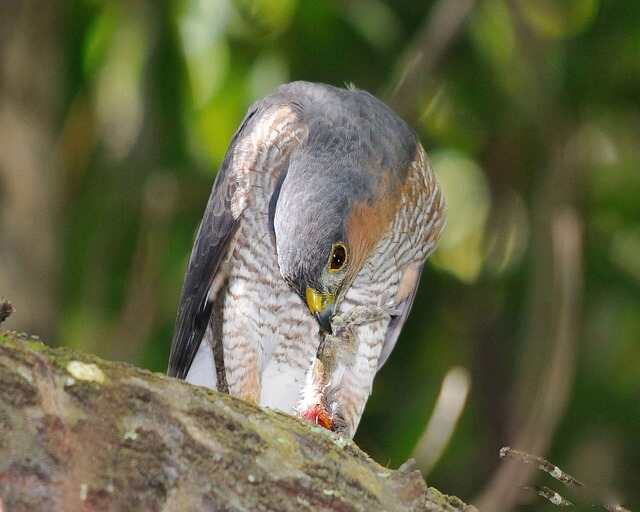
Other Predators of Blue Jays
Several other predators, including owls, snakes, and domestic cats, are known to prey on blue jays. Predator behavior towards blue jays varies depending on the type of predator, their habitat, and the availability of prey.
For example, owls are known to hunt blue jays at night, while domestic cats tend to hunt during the day. Snakes, on the other hand, are ambush predators that wait for blue jays to come within striking distance.
These predators have an ecological impact on the blue jay population, as they can reduce the number of blue jays in a particular area.
However, blue jays have adapted to these threats by developing alarm calls and mobbing behavior, which can alert other blue jays to the presence of predators.
Understanding the interactions between blue jays and their predators is important for understanding the significance of blue jays in the ecosystem.
The Significance of Blue Jays in the Ecosystem
Blue jays play a crucial role in distributing and dispersing seeds throughout their ecosystem, with studies showing that they can transport up to 5000 acorns in a single fall season.
This is due to their behavior of caching food items such as nuts and seeds, which they bury in the ground for later consumption.
However, not all of these caches are retrieved, leading to the unintentional planting of seeds in new locations.
In addition to their seed dispersal role, blue jays also contribute to the ecosystem by preying on insects and small animals, and by serving as a food source for larger predators.
Conservation efforts for blue jays focus on protecting their habitats and reducing the use of pesticides, as well as promoting awareness of their importance in maintaining healthy ecosystems.
Overall, blue jays play a vital role in maintaining the balance of their ecosystem and should be recognized for their contributions to the natural world.
Frequently Asked Questions
What is the lifespan of a blue jay?
The average lifespan of a blue jay is 7 years. Blue jays are omnivores and their diet includes insects, seeds, fruits, and nuts. They have several predators, including cats, snakes, and birds of prey.
How do blue jays communicate with each other?
As the adage goes, “communication is key.”Blue Jays utilize a variety of vocalizations to communicate with each other, ranging from alarms to mating calls. Their social behavior also includes territorial defense and cooperative breeding.
What is the habitat of blue jays?
Blue jays inhabit forest canopies and feed on a varied diet that includes acorns, insects, fruits, and seeds. Their habitat preference and diet variations are essential to their survival and reproductive success.
How do blue jays defend themselves from predators other than hawks?
Blue jays utilize a variety of predator defense strategies, including mobbing, alarm calls, and vocalizations. Their alarm calls can alert other birds and animals to potential danger, while their aggressive mobbing behavior can deter predators.
What is the population of hawks and blue jays in North America?
The population of hawks and blue jays in North America is difficult to estimate, but conservation efforts have been implemented to protect both species. Hawks generally have a wider range and migrate farther than blue jays, which have more localized migration patterns.
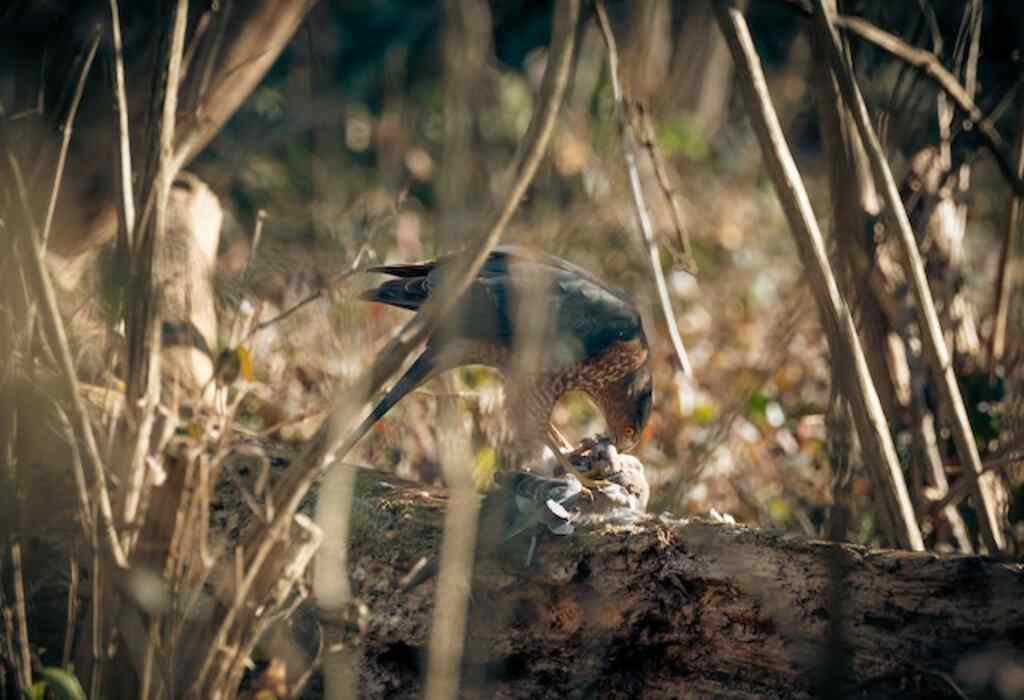
Conclusion
In conclusion, the relationship between hawks and blue jays is a complex one. While hawks do prey on blue jays, it is not a common occurrence. The diet of hawks is varied and they typically prey on smaller animals such as rodents and insects.
Blue jays, on the other hand, are known for their aggressive nature and are not easy prey for most predators.
Research studies have shown that the probability of a hawk preying on a blue jay is affected by factors such as habitat, time of day, and season. Other predators of blue jays include squirrels and snakes.
Despite their reputation for being a nuisance, blue jays play a significant role in the ecosystem as seed dispersers and insect controllers.
In a satirical twist, one could argue that the real question is not whether hawks eat blue jays, but rather, do blue jays eat hawks?
After all, who’s to say that these seemingly harmless birds aren’t secretly plotting to take down their larger feathered counterparts?
Perhaps it’s time we start keeping a closer eye on these mischievous avian creatures.
But in all seriousness, the relationship between hawks and blue jays is a fascinating example of the delicate balance of predator and prey in the natural world.

